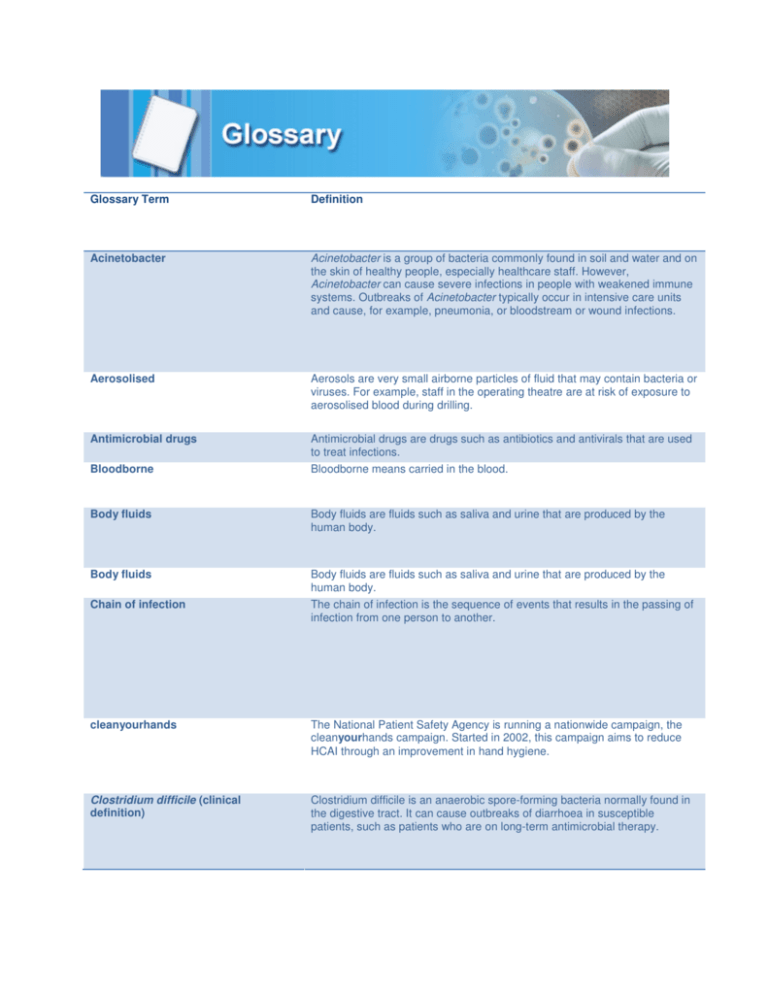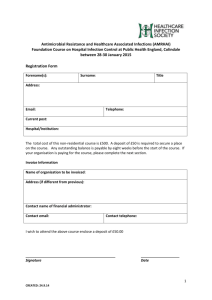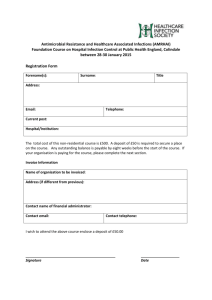Glossary Term Definition Acinetobacter Acinetobacter is a group of
advertisement

Glossary Term Definition Acinetobacter Acinetobacter is a group of bacteria commonly found in soil and water and on the skin of healthy people, especially healthcare staff. However, Acinetobacter can cause severe infections in people with weakened immune systems. Outbreaks of Acinetobacter typically occur in intensive care units and cause, for example, pneumonia, or bloodstream or wound infections. Aerosolised Aerosols are very small airborne particles of fluid that may contain bacteria or viruses. For example, staff in the operating theatre are at risk of exposure to aerosolised blood during drilling. Antimicrobial drugs Antimicrobial drugs are drugs such as antibiotics and antivirals that are used to treat infections. Bloodborne Bloodborne means carried in the blood. Body fluids Body fluids are fluids such as saliva and urine that are produced by the human body. Body fluids Body fluids are fluids such as saliva and urine that are produced by the human body. Chain of infection The chain of infection is the sequence of events that results in the passing of infection from one person to another. cleanyourhands The National Patient Safety Agency is running a nationwide campaign, the cleanyourhands campaign. Started in 2002, this campaign aims to reduce HCAI through an improvement in hand hygiene. Clostridium difficile (clinical definition) Clostridium difficile is an anaerobic spore-forming bacteria normally found in the digestive tract. It can cause outbreaks of diarrhoea in susceptible patients, such as patients who are on long-term antimicrobial therapy. Clostridium difficile (non-clinical definition) Clostridium difficile is a bacteria sometimes found in the digestive system. It can cause outbreaks of diarrhoea in susceptible patients, such as patients on long-term antimicrobial therapy. It is commonly known as C diff. Commensal Commensal is another name for normal flora, the friendly microorganisms, mainly bacteria, that live on or in the human body. Contaminated Contaminated means to have come into contact with harmful substances such as disease-causing microorganisms. Culture plate A culture plate is used in laboratories to grow microorganisms. Damp dusting Damp dusting means dusting with a damp cloth. Disinfectant granules A dry preparation of a chemical disinfectant, usually sodium hypochlorite (bleach), that will destroy harmful microorganisms. Commercial preparations include Acticlor™, Saniclor™, Presept™ and Haztabs™. Drug-resistant infections Drug-resistant infections are infections that have evolved to develop the ability to resist the antimicrobial drugs such as antibiotics that are used to destroy them or to prevent them from spreading. When an infection is resistant to more than one antimicrobial drug it is said to be multiple-drug resistant. Eczema Eczema is a non- infectious inflammation of the skin. It causes the skin to become red and itchy. It may also cause the skin to crack, bleed and become crusty and scaly. Endogenous infection An endogenous infection occurs when microorganisms move from their normal 'home' in or on your body and invade your tissue. Entry point An entry point is where the microorganism can get into another person. This could be through the mouth when eating and drinking, through the nose and mouth when breathing, through cuts or broken skin such as wounds, and via drips and drains such as urinary catheters. Exit point An exit point is a site where microorganisms leave the host such as on skin, blood and bodily fluids or via breath. Exogenous infection An exogenous infection occurs when you are exposed to microorganisms your body is not familiar with and you do not have antibodies against them. Colds and flu or gastroenteritis are good examples in normally healthy individuals. Faecal-oral route The faecal-oral route is the method by which microorganisms excreted in the faeces can contaminate your hands, which can then contaminate food if you touch it. If other people eat the food, they can become infected with the microorganisms. Fluid-repellent gowns A fluid-repellent gown is a gown that does not absorb water, blood or other fluids. Glass and aerosols disposal box This is a box used to collect only non-clinical aerosols and glass for recycling. It is sometimes known as a magpie box. Hazardous substances Hazardous substances include biological agents found in some cleaning products, detergents and disinfectants, and microorganisms in blood, body fluids, dust and dirt. Healthcare Setting A healthcare setting is any location in which a patient receives care. This includes clinics and general practices, hospitals and out patient departments. Healthcare-associated infection A healthcare-associated infection is an infection that develops as a direct result of any healthcare treatment. The infection is not present when a patient begins the healthcare treatment. High dusting High dusting is done on a rotational basis. It involves cleaning areas such as walls and ceilings, ventilation ducts, curtain rails etc. HIV Human Immunodeficiency Virus (HIV) destroys the body’s immune system and causes AIDS (Acquired Immune Deficiency Syndrome). HIV is spread by blood and other body fluids. For this reason, healthcare workers need to continually prevent contact with patient blood and body fluids. Immune system An immune system is the body’s defence against harmful microorganisms (germs). Infected linen Infected linen is linen that has been used for an infected patient. Intravascular catheter (clinical definition) Intravascular catheters include central venous and arterial catheters and their use is associated with an increased risk of bloodstream infections (BSI). Peripheral intravenous catheters may cause local infection and inflammation but rarely cause BSI. Intravascular catheter (non-clinical definition) An intravascular catheter, commonly known as a drip, involves the introduction of a fluid such as saline by gravity into a vein. Invasive procedure An invasive procedure is a procedure in which the body is cut open. Isolation room An isolation room is used for patients who are suffering from certain infectious illnesses. Isolation is a precaution taken in a hospital to prevent the spread of infection from an infected patient. Isolation rooms are also used to protect patients who are not infectious but have lowered immunity and may be at risk of easily acquiring infections from others. Linen Linen includes sheets, towels, pillowcases, bed covers and bedclothes. Method of spread A method of spread is the route by which an infectious agent can spread. Methods of spread can include direct or indirect contact such as hands or shared equipment. Other methods include air, blood or the faecal-oral route. Meticillin-resistant Staphylococcus aureus (MRSA) MRSA is a type of Staphylococcus aureus commonly found on human skin and the inside of the nose. Some people carry MRSA without signs of infection, but if it causes an infection it can be difficult to treat. Microorganisms Microorganisms are microscopic life forms, also known as germs. Some of them are beneficial to humans but others, such as bacteria and viruses, can cause infections. Mucous membrane A mucous membrane is a moist tissue lining body openings or passages, such as the mouth, throat and vagina. Mucus is a slimy substance produced to make body tissue slippery and reduce damage from friction. National evidence-based guidelines National evidence-based guidelines are systematically developed, broad statements (principles) of good practice that assist in decision-making in relation to preventing healthcare-associated infections. There are two sets of national guidelines currently available: the epic guidelines for preventing healthcare-associated infection in acute care settings (2001) and the NICE guidelines on Prevention of Healthcare-associated Infection in Primary & Community Care (2003). National guidelines National guidelines are systematically developed, broad statements (principles) of good practice that assist in decision-making in relation to preventing healthcare-associated infections. There are two sets of national guidelines currently available: the epic guidelines for preventing healthcareassociated infection in acute care settings (2001) and the NICE guidelines on Prevention of Healthcare-associated Infection in Primary & Community Care (2003). Norovirus The norovirus belongs to a group of related viruses that cause acute gastroenteritis, sometimes called the stomach flu. Open tuberculosis Tuberculosis (TB) is a bacterial disease that commonly infects the lungs, but can infect any part of the body. It can be transmitted from one person to another, usually as a result of prolonged personal contact. Open tuberculosis refers to TB of the lungs that is infectious. Organic matter Organic matter includes dirt, dust, food or drink, blood, or body fluids. Your hands may not look dirty and yet be contaminated with organic matter. Sometimes, hands just feeling dirty is an indication that they may be contaminated with organic matter. Particulate filter respirator A particulate filter respirator is used by healthcare workers when caring for patients with certain infectious diseases such as tuberculosis and SARS. Particulate filter respirator_Clinical_Version A particulate filter respirator (PFR) is a specially designed mask made to fit over the mouth and nose. When correctly fitted, it will not allow air to pass from around the edges only through the fabric of the mask. This then filters out any airborne microorganisms. PFRs are used when caring for patients with certain infectious diseases such as tuberculosis and SARS. Pathogen A pathogen is a microorganism that may cause disease. Pathogenicity Pathogenicity is the ability of a microorganism to cause disease. PEAT Patients’ Environment Action Teams (PEAT) were created by NHS Estates to ensure the patients’ environment was of an acceptable standard. Their monitoring covers a range of issues including privacy, cleanliness, quality of food and signs around the hospital. Person at risk A person at risk is someone at risk of infection. This could be for a variety of reasons, such as surgery, prolonged stay in hospital, invasive medical devices, chronic illness and lowering of their body's normal immune response, or being cared for in intensive care. Personal protective equipment Personal protective equipment (PPE) is equipment recommended for use by healthcare workers when undertaking specific healthcare actions, or when caring for patients with specific infectious diseases, to reduce the risk of spreading infection. PFR A particulate filter respirator is used by healthcare workers when caring for patients with certain infectious diseases such as tuberculosis and SARS. Psoriasis Psoriasis is a non-infectious inflammatory skin disease. It causes red patches on the skin, that are covered with silver coloured scales. Screening Screening means carrying out tests on a large number of people to find out how many of them have a particular disease. Single use Items that are single use are used for only one task. For example, a disposable apron should be used for one task and then disposed of. Before starting a new task, put on a new apron. Sodium hypochlorite A disinfectant, commonly known as bleach, that can be used in different strengths to clean up spillages. Soiled linen Soiled linen is linen that is visibly stained with blood or body fluid. Source A source, also known as a reservoir of infection, is a place where a microorganism has all of the things it needs to grow and multiply including warmth and moisture. Humans make ideal sources for microorganisms. Spores Spores are a form of microorganism. They have a thick protective coat that allows them to remain alive but inactive in the environment for long periods of time. Many of the cleaning products commonly used do not kill spores. Spot Cleaning Spot cleaning is required to deal with visible dirt, such as splashes on floors and walls. This should be carried out in addition to your regular cleaning schedules. Spot cleaning of splashes should be carried out as part of routine cleaning. Standard precautions Standard precautions are basic infection control practices that everyone working in healthcare must apply to prevent the spread of infection. These include hand hygiene, use of PPE, decontamination, and the correct disposal of sharps and waste. Swabs Small pieces of absorbent material. They are used to clean wounds or apply medicine. Theatre linen Theatre linen is linen that has been used in the operating theatre. Transient flora Transient flora are organisms that are acquired on the hands through contact with patients or with equipment that is contaminated. Unknown source patients Patients who have been infected or colonised but show no symptoms are called unknown source patients. We should never assume the infectious status of any patient, as some infections have periods when there are no symptoms, e.g. HIV, Hepatitis B. Colonisation is also asymptomatic but a patient colonised with MRSA will be a significant source of a microorganism that, if transmitted to another patient, could cause a serious infection. Urinary catheter A urinary catheter is a tube inserted into the bladder via the urethra (the part of the body through which urine is discharged). It remains in place for a period of time to drain urine. Used linen Used linen is linen that has been used but has no visible stains. VRE VRE, vancomycin-resistant enterococci, is one of the most common bacteria that cause infections in hospitals and other places where patients are treated. Enterococci are microorganisms that are found in the intestine and cause infections in the bloodstream and surgical wounds. One particular type of enterococci, VRE, is resistant to many antibiotics. Waste stream Waste is separated into different waste streams depending on what category it belongs to. In a hospital, waste is usually dealt with in two major streams: domestic (non-clinical) waste and clinical waste. The different streams must not be stored or transported together.




